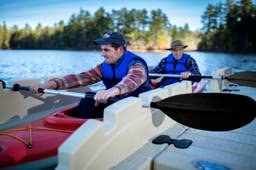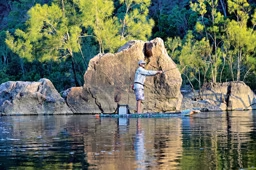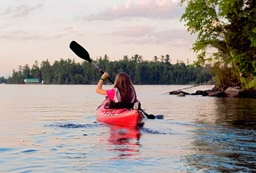
The glassy water off your dock ripples slightly as you ease your kayak into it. It’s early morning, mist is rising off the lake, and the rest of the world is sleeping. It’s a time when you can be one with nature, and call the serene plane of water – stretching out in front of you as far as you can see – your own.
Kayaking is one of the best ways to explore whatever lies beyond your dock, whether you’re looking for moving meditation, exercise, a way to spend time with family or just plain fun. And when you take time to learn the ropes, you’ll not only have more fun, but you’ll be safe – able to handle whatever water and weather you encounter.
See also White Sangria
According to Todd Wright (expert kayaker, instructor and coach) the best thing you can do to maximize your kayaking enjoyment is to take a lesson where you’ll learn about kayaks and kayak safety.
And lessons are a great investment to make before the larger investment of a kayak. “Whether you’re considering retrofitting or buying a boat, a lesson can mean the difference between buying your perfect craft from the get-go and investing in a boat you might outgrow in a single season,” explains Wright.
Until you have a chance to find the best instructors in your area, Wright offers the top tips he shares with students when he is instructing.
Suit Up
Before you buy a boat, buy a paddling specific PFD that feels so good you’ll wear it all the time. Make sure it has big cutouts at the arms for freedom of movement, a high back that doesn’t get in the way of the kayak seat, and that it stays in place as you paddle and doesn’t ride up.Get Comfortable
Wright says, “Paddling should never cause pain or discomfort. If your feet are falling asleep or your back hurts, swap out your seat, add some back padding or [have a professional] check your boat fit.”When shopping for a new kayak, choose a boat that fits you comfortably and that isn’t overly snug (a sea kayak should be trim but not tight).
Dip In
For maximum power and efficiency, submerge your paddle blade fully before you pull into it.To find your sweet spot – the ideal place where your paddle should enter the water – rotate your chest to the right twisting from the waist, and place your left hand on the side of the boat. Then (as shown in the right-hand photo on the next page) twist into the same position while holding your paddle and place your left paddle blade in the water. That will be your ideal entry point for your right paddle blade. Keep a light grip on the shaft.
See also The Best Life Jackets for Dogs
Give Your Arms A Break
Abdominal muscles are a lot bigger and stronger than arm muscles, so use them to power your boat, rather than your arm muscles. Once the paddle blade is in the water, don’t think about drawing the blade towards you. Simply unwind the twisting motion described above, using your core muscles, and the boat will move forward.The paddle will climb out of the water, and your body will automatically be in the recovery position, ready for the next twisting stroke.
Wright recommends taking 30 strokes with completely straight arms to start to teach yourself the twist.
Practice Without Your Rudder
Many boats have an optional foot-operated rudder that makes steering easier. It’s nice to have, but it’s important to learn to steer your boat without it.Wright says the key to maneuvering your kayak is to transfer your weight from flank to flank. Turning a kayak can be counterintuitive, as sea kayaks are designed to turn on their outside edge. Pressure your left flank to turn right and vice versa.
Learn to steer your boat without the rudder, but definitely use your rudder in wind or waves.
Sit Tall
Proper posture can make or break a long day of paddling. The best position: sit up straight so your entire backside is in contact with your seat. Your back should be in contact with the seat, though not pushing into it. Thighs should be in gentle contact with the thigh braces, and your knees in gentle contact with the hull. Balls of your feet should be on the foot braces, but there should be plenty of room to take your feet off and get the blood in your legs flowing.Swim
After you’ve completed your lessons and feel comfortable out on your own, pick a day when the weather is good and you’re close to your home shore, and push the boat to its limits. See how far you can put the boat on edge (how far you can tip it to one side) before it goes over, and then practice a wet exit and re-entry using a paddle float or another technique. If you’re paddling a boat with a cockpit skirt, you’ll need to practice pulling the skirt once you’ve entered the water (it’s a good idea to practice this a few times while dry before applying it in a wet exit).
See also Man Overboard
A paddle float is an inflatable sleeve that fits over your paddle blade. To re-enter the boat from the water, take the paddle float off your boat (most paddlers store it behind the cockpit under a bungie where it’s easily accessible), inflate it (just takes a few breaths) and slip it over the blade of the paddle. Insert the other end of the paddle under the rim of the kayak’s cockpit and press on the paddle shaft. It will act like an outrigger and will offer you support to help you climb back into the boat. Use a bilge pump to clear water from inside the boat.
Getting comfortable with your boat’s limits, as well as learning how to self-rescue, will give you greater confidence on the water and help you have a better time – whether you’re exploring the shoreline around your cabin or tackling an open water crossing.
“When you’re safe, you’ll have fun and be able to enjoy your time on the water without worry,” says Wright.
So, follow the advice above, and easy and efficient strokes will quickly become second nature. When you’re more efficient, you can cover more terrain and explore more distant shores.
Berne Broudy is a Vermont-based writer, photographer and adventurer.










